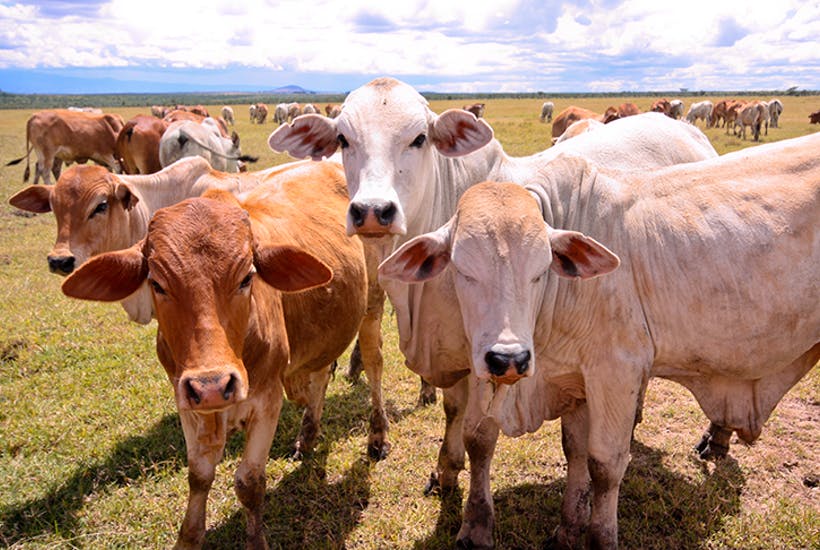Death and failure are more integral to farming than any other experience that I’ve witnessed in my life. Some things are out of our hands — like the plagues of desert locusts heading our way from Ethiopia, promising to devour all our green pastures within hours of their arrival. Other things are within our power, such as the life of our animals who, though we want them to be contented during their stay on the farm, are mostly headed towards one inevitable end.
Seconds after one of our Boran cows gives birth, she will begin to nuzzle her calf who will quickly stand and suckle its mother. It’s harder when a heifer is calving for the first time because she is more prone to reject her calf. When this happens we might bind the mother’s rear feet and help the calf to suckle, which stimulates the release of oxytocin. The first colostrum is let down and the love flows between them.
In late November a first calf heifer that I favoured gave birth to a bull calf and immediately gave him such a mighty kick that his near hind leg broke, the tibia and fibula sheared in two. The break was so bad I resolved to put him out of his misery, as we usually do with hopeless cases that get chopped up and put in the freezer or made into dog food. On a whim this time, after a chat with the farm stockman Leshoomo, we agreed to have a go at saving the miserable creature. Leshoomo fashioned a splint from a plastic bottle, some rags and a length of sisal baler twine. Since the mother went mad if her calf was brought close to her we resorted to feeding the calf with a mixture of other cows’ milk and old tins of powder and bottles saved from when our children were babies.
What happened next was an important chapter in the farm’s history. For several days the calf lay sadly by himself. He couldn’t stand but he became alert at bottle-feeding times and his dull red coat took on a glossy sheen. After a week he could stand and within a fortnight he walked with a peg-leg shuffle. I called him Long John Silver. Unable to pronounce this, the fierce askari Ekuwom decided his real name was Lomojong — which means ‘big old bull’ in the local Turkana language. A warrior and cattle raider in his youth, Ekuwom woke the calf up each morning from his bed of hay and gave him a drink of milk. After that he’d come and hang around the kitchen waiting to be fed up to eight times a day. He spurned ordinary dairy milk powder and so we fed him the expensive stuff, together with an egg whisked into it. The black cat Bernini hissed at him and he fell over, but our three dogs licked his face and made him part of the family. Like a dog, he comes running towards you if you call his name. ‘Hello Long John,’ people say as they pass him, or, ‘Hello Lomojong’.
These days Long John walks without a limp and like any other calf he skips around when he is excited. He pined for Ekuwom when he went on Christmas leave and delightedly ran around in circles on the day his handler returned. Long John is terrified of other cattle and runs away at the sight of them, but these days he rather likes pretending he’s a sheep and grazes alongside them in the flock that wanders around our farmstead paddocks. He still refuses to drink his milk from a bowl unless he can suck on your finger at the same time. If the house doors are left open he will wander around chewing socks, curtains and shirts. He stands in the kitchen gazing at my daughter Eve while she cooks lunch and I’ve seen him quietly watching television.
All farmers develop a soft spot for certain animals. My neighbour Mark buries his favourite bulls in the garden with full honours, as if they were Viking chieftains. Often we make harsh decisions when it comes to sick or injured livestock and since they are not pets we send our animals to the butcher or sell them on as breeding stock to other farms because this is a business. Still, I think Long John Silver has helped remind all of us on the farm about the value of life. We can never send Long John to the butcher, though — so I guess he’s going to grow into a 500kg house bull.







Comments